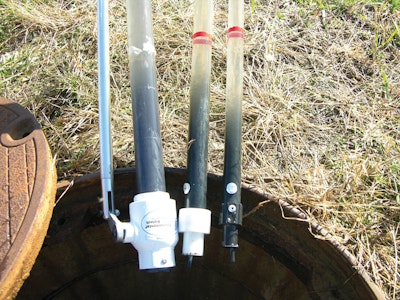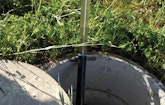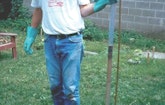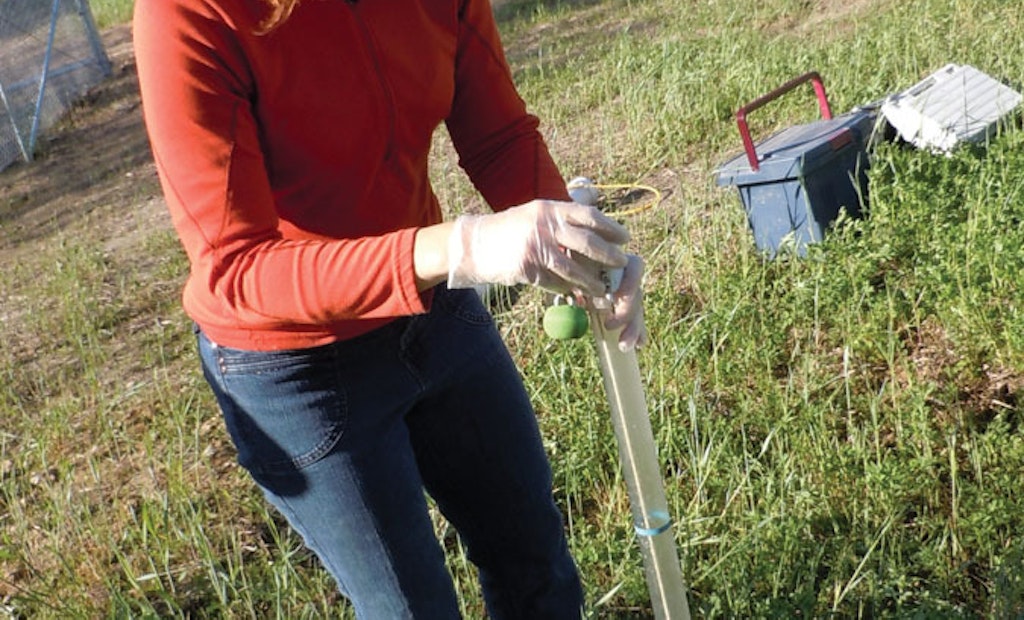Interested in Onsite Systems?
Get Onsite Systems articles, news and videos right in your inbox! Sign up now.
Onsite Systems + Get AlertsMany products are manufactured specifically to periodically measure sludge and scum accumulation — or you could make your own. These devices can be used in septic tanks, flow equalization tanks, grease traps, recirculation tanks, pump tanks and even aerobic treatment units to evaluate the buildup of sludge and scum.
In the past, a “stick test” using a white rag or towel was often recommended, but professionals today have a variety of purpose-built tools to do the job. Some of the most common propriety brands are DipStick Pro (Environmental Biotech), Sludge Judge (Nasco Whirl-Pak) and TruCore (Sim/Tech Filter). This list is not exhaustive, so you may have another one you like! The proprietary devices are made using clear PVC pipe typically with a marking every foot. The pipe takes a core of the tank liquid profile and you can then calculate the levels of sludge and scum.
A DEEPER DIVE
The devices operate differently, so when deciding which one to purchase it is good to understand what type of systems you typically need to evaluate.
- The Sludge Judge comes in several diameters and lengths and has a ball that lifts up as liquid and solids enter the tube. When you retrieve the core, the ball sits at the bottom, trapping the effluent inside; you need to be sure that the foot valve seats before pulling it out. With very thick sludge, the ball may have issues letting the sludge into the tube. The larger diameter model (1 ¼ verses ¾-inch) seems to have less of an issue with this, but I have still plugged ours with very dirty tanks. It typically comes with three sections for a total of 15 feet, which is nice if you deal with deeper and larger tanks. Cleaning can be challenging with the ball blocking flow at the bottom.
- The DipStick has an open bottom and a ball valve that you close after filling the tube. There is a T-handle and an arm lever to operate the ball. The larger-diameter opening is nice (1 ¼ inches). It comes as a 6-foot section, but you can add 4- or 6-foot extensions. Over time we have had issues with the ball on valve easily opening and closing but a lubricant such as WD-40 can help with that. Due to the open bottom it is less likely to plug with heavy solids. The device is easy to clean.
- The TruCore has an open bottom with a gasket and plug, which is pulled tight when the pipe is full. The opening at the bottom has a diameter of 1 3/8 inches. With the open bottom it is less likely to clog and you can easily measure thick sludge as fluid is allowed to flow freely into the sampling tube. The device is easy to clean.
All these devices are challenged by a thick, heavy scum layer. You need to open a pathway (typically with a shovel) before inserting these tools. Always be sure to drain the device back into the tank.
You will want to check the levels in each tank or compartment. We normally expect the first tank/compartment to have the most sludge and scum, but with heavy water users, sludge and scum may have pushed to downstream components. Tanks or compartments should be cleaned out when the middle/outlet side of the tank when more than 25% of the tank liquid capacity is storing sludge and scum.
You do also want to check at the inlet side of the first tank, as there are some commercial facilities that may accumulate sludge at the front end of the first tank. Letting these systems go too long without service could cause a backup or surfacing. In many commercial facilities and cluster systems served by multiple tanks, only the first tank or compartment will need cleaning, resulting in substantial savings.
MEASURE AGAIN
As part of a study done at the University of Minnesota, we found sludge measurements varied significantly depending on the sampler, and the speed with which the instrument was lowered into the tank. We observed the most consistent readings when the instrument was lowered into the tank slowly (at a rate of approximately 1 foot per second), and when the measurements were taken by the same person. Despite the adoption of this protocol, sludge measurements still varied significantly within a manhole; as a result, several sludge measurements are recommended.
Once you have a liquid profile of the tank, we need to evaluate how the tank is performing and if maintenance is needed.
Scum - The scum layer should be present but not excessively thick with at least a 3-inch zone between the bottom of the sludge and the outlet baffle/screen. A missing scum layer can be the result of a loss of the outlet baffle or chemicals being added to the tank. A thick scum layer is typically the result of fat, oil and grease and excessive soap usage. It can also contain debris that is lighter than water and should not be flushed. If a particularly thick scum layer contains a considerable proportion of undigested food, there is usually a problem in the house, either with excessive garbage disposal use or a medical problem related to food digestion or bulimia.
Clear Zone - The clear zone should be at least 75% of the tank depth. The appearance of flocculent (small floating solids) will also speak to tank operation. A clear zone with little flocculent means the tank is working well. An absent clear zone (where tank profile is uniform) is the result of an anti-bacterial addition that has significantly impacted bacterial action.
Sludge - The sludge accumulation should not reach to within 12 inches of the bottom of the outlet. A thick sludge layer in a short period of time may relate to heavy use of a garbage disposal, particularly if the home is adding difficult-to-decompose materials such as coffee grounds, tea bags, bones or citrus fruit peels. The more people living in a home, the more sludge will be produced.
In the future we may have electronic devices to measure sludge and scum depths that can be connected to wireless technology to indicate when septic tanks need cleaning. But until then, every service provider should have a sludge measuring device.









